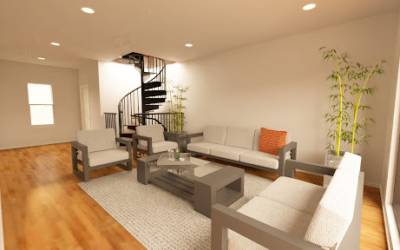Renovating a mixed-use property in Philadelphia requires a great design team and a building permit from the city. A mixed-use property is a building that combines residential, commercial, and sometimes industrial units.
First, you will need a great development/architectural team to design the project. A team that understands that when applying for permits for Mixed-use property renovations, there are many factors that can affect the many scenarios you may encounter. These scenarios will determine how the permit navigation process will go.
One of the factors in determining what permits will be required is the degree of renovation work needed in total, meaning how much of the renovation work will be done in the commercial area and how much of the renovation work will be done in the residential area. These factors will play a big role in the complexity of your design and the permit process.
Keep in mind that in commercial renovations, the permit process is dependent on the intended use of the space. There is a difference in the permit process if the commercial renovation is going to be used as a kitchen/restaurant or simple office space, for example. This is why you want to have a good development/architecture team who will design the project and help guide you through the permit requirements. Also, keep in mind, some architects can be very expensive so shopping around is essential.
We have been renovating a mixed-use property in Philadelphia. In this article, we will discuss how we are navigating the design and permit process. We will also cover the new Licenses and Inspections (L&I) rules that went into effect March 22, 2023.
Figure 1
Renovating a Mixed-use Property in Philadelphia: Our Story.
Our project involved renovating a mixed-use property in Philadelphia. It is a three-story building plus a basement. The first floor is dedicated to commercial space. As you can see in Figure 1, the commercial space was originally a Chinese Restaurant. We are not sure if it was a sit down place or a take-out only place. Currently, the owner has closed the restaurant and is not utilizing the commercial space. Surprisingly, the commercial kitchen appears to be intact and in relatively good condition.
The two upper floors were a residence where the owner of the restaurant was living. Interestingly, there was no separate entrance for the residential area, so the owner had to pass all the way through the commercial space, including the commercial kitchen, to access a staircase at the back of the building which led to the residential area.
The new owner wanted to renovate the entire second and third floor residential area, keeping it a single family residence. They also insisted on having a separate entrance to the residential space. To make a private entrance to the residential area, we had to relocate the stairs to the second floor to the front of the building; the back stairs were closed off. We did not renovate any part of the commercial space as part of this project. In Figure 2 you can see 3D models of the existing floor plans.
Figure 2: left to right (first floor, second floor, third floor)
Let’s take a closer look at the process we went through for this project.
Designing Our Mixed-Use Property in Philadelphia
The first step was to create architectural plans that took into account the owner’s needs and the city building codes. Figure 3 shows the design we came up with and how we reconfigured the design to meet the owner’s preferences. The design shows four bedrooms, two bathrooms, a large master bedroom, a utility/mechanical room, and an open concept area consisting of a kitchen, living room, and dining room. You can also see the relocated stairs leading to the 2nd floor.
Sometimes, the owner may want something that does not comply with the codes. For example, the owner of our project wanted a small utility/mechanical room that was not code compliant. Therefore, we could not make that happen. In this case, Our Design Team, who has a good understanding of city building codes, explained this to the owner. They also provided code-compliant alternative options.
Throughout the design process, there was ongoing collaboration and communication between the designer and the owner. We worked together to ensure the final design met all the city requirements and the owner’s expectations.
When it was time to apply for the permits, we made sure the drawings had been reviewed and officially sealed by an architect. This project required us to obtain the following permits: building permit, electrical permit, plumbing permit, mechanical permit, and a zoning permit.
Remember, there are times when major changes need to be made during the architect’s review. In this case, you should inform the owner before making those changes. The architect’s review is a crucial step in moving forward with the project and getting the necessary approvals. Therefore, good communication with the owner helps keep things moving.
Figure 3: left to right (first floor, second floor, third floor)
New Rules As of March 22, 2023
In home renovation projects, it is common for certain parts of the project to impact adjacent properties. The safety of residents and their properties is a top priority. For this reason, L&I (Licenses and Inspections) has additional requirements for these situations.
The new rules apply to the following scenarios:
- If doing excavation work more than five feet below ground and within 10 feet of a neighboring building or structure.
- The project involves excavation, demolition, or construction within 90 feet of a historic structure on the same or nearby property.
- If making modifications to a shared wall, such as tearing it down, replacing joists, or adding new sections.
- If cutting or removing a roof or wall that spans across multiple properties.
Since March 22, 2023, L&I requires specific documents for any renovation or construction work that impacts adjacent properties. These documents include:
- A pre-construction survey where an engineer physically inspects the property and looks into associated records.
- A monitoring plan ensuring that the proposed activities do not have a negative impact on the building’s structural integrity.
- A written notification informing the owners of adjacent properties about upcoming construction or demolition activities.
How the New L&I Rules Applied to Our Project.
Because our project has one adjacent wall, we were required to follow the above mentioned new rule. We encountered scenario number 3 as a result of having to relocate the stairs from the first floor commercial space to the above residential area to make the private entrance the new owner wanted.
In our specific project, the owner wanted to move the staircase. To make that happen, we had to remove floor joists and create an opening in the first floor ceiling. To comply with L&I’s regulations, we had a licensed engineer conduct a Pre-construction Survey. The engineer determined that we had to temporarily support the adjacent party wall to prevent any risk to the structure (see Figures 4 and 5). Removing the joists could have potentially compromised the stability of the party wall and ceiling. By providing temporary support, we ensured the wall remained safe and secure until we finished installing the staircase and floor joists.
While renovating the mixed-use property in Philadelphia, this approach allowed us to meet the owner’s requirements and maintain structural integrity.
Figure 4
Figure 5
Submitting the Permit Applications on Eclipse
One of the most important steps when renovating a mixed-use property in Philadelphia is getting the required permits.
Once we gathered the necessary documents for the building permit, it was time to submit the permit application on Eclipse. A full list of required documents can be found here. The exact documents you will need depends on your project and scope of work.
For our project, we submitted the following documents:
- Application Form
- Architect’s Sealed Plans
- Owner Acknowledgment
- Monitoring Plan
- Statement of the Special Inspection Schedule
- Special Inspections, Duties and Responsibilities Agreement
- Waste Hauler Form
- Change of Ownership Document
Documents 1 and 2 are required for almost all building permits. Documents 3, 4, 5, and 6 are specifically required by L&I for any construction or renovation that impacts adjacent properties, as mentioned in the previous section. The Waste Hauler form is used to report waste hauling activities. Finally, the Change of Ownership document is necessary when there is a change in property ownership and the new owner wants to begin work promptly.
Any other permits needed, such electrical or plumbing, can also be submitted on Eclipse. If the ownership of the property has changed, submit the Change of Ownership documents with all permits. Keep in mind that you may need to submit a drawing for other permits, such as mechanical or plumbing. It depends on your project’s scope of work. Otherwise, these permits do not require the above documents.
Communicating with the City When Renovating a Mixed-Use Property in Philadelphia.
As a 203(k) contractor in Philadelphia, we have gone through the permit process many times. We know that every renovation project comes with its own exclusive challenges. Chances are, the city will ask us to provide more information or additional documents. We have found that a back-and-forth discussion, with the city to resolve any issues and ensure we meet their requirements to get the permits, is the best option.
To clear up any confusion, we will often set up a Zoom meeting with the department of L&I. It gives us the opportunity to ask questions, address any concerns, and get the guidance we need. This can be especially helpful if we are feeling overwhelmed with all the requirements when renovating a mixed-use property in Philadelphia. Remember, they are there to assist you and ensure the process goes smoothly. So, don’t hesitate to reach out and get the support you need!
Owner and Contractor Communication
We feel good communication between the owner and us, the contractor, is of the utmost importance. The owner should know all the project details and is encouraged to stay in touch with us. Oftentimes throughout the process, we require the owner to be involved in one aspect or another related to the project. So having a good line of communication is essential. By talking and sharing information, we know the project will go well and meet the owner’s expectations.
Conclusion
To sum it up, creating a design and getting a building permit when renovating a mixed-use property in Philadelphia can be a complex process that requires attention to detail. It is important to understand the scope of your project. Also, you need to have a good design team and an experienced contractor who knows the rules and regulations. This will help ensure everything goes smoothly.
Whether you dream of renovating a mixed-use property in Philadelphia or just a residential building, Matrix Company Solutions Corp. is here to help. We will guide you through the design and permit process, all the way to the exciting moment when you enter your newly renovated property.
If you have any questions or need assistance, don’t hesitate to reach out to us. We offer a FREE Consultation and we are here for you every step of the way!




![Top 20 Reasons for Failing a Plumbing Inspection in Philadelphia [2025 Guide]](https://matrixgc.com/wp-content/uploads/2025/05/Common-issues-causing-failing-a-plumbing-inspection-in-Philadelphia.png)



0 Comments